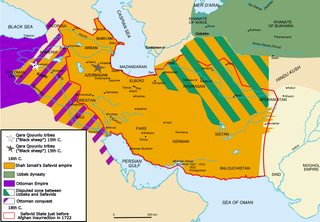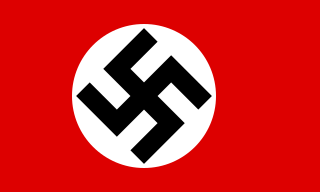 W
WThe history of the Caucasus region may be divided by geography into the history of the Northern Caucasus (Ciscaucasia), historically in the sphere of influence of Scythia and of Southern Russia, and that of the Southern Caucasus in the sphere of influence of Persia, Anatolia and Assyria.
 W
WThe campaigns of Nader Shah, or the Naderian Wars, were a series of conflicts fought in the early to mid-eighteenth century throughout Central Eurasia primarily by the Iranian conqueror Nader Shah. His campaigns originated from the overthrow of the Iranian Safavid dynasty by the Hotaki Afghans. In the ensuing collapse and fragmentation of the empire after the capture of the Iranian capital of Isfahan by the Afghans, a claimant to the Safavid throne, Tahmasp II, accepted Nader into his service. After having subdued north-west Iran as well as neutralising the Abdali Afghans to the east as well as turning Tahmasp II into a vassal, Nader marched against the Hotaki Afghans in occupation of the rest of the country. In a series of incredible victories the Afghans were decimated and Tahmasp II returned to the throne as a restored Safavid monarch.
 W
WThe Caucasus Campaign of 1734–1735 was the last great campaign of the Ottoman–Persian War (1730–35) which ended in a Persian victory allowing Nader to recast Persian hegemony over almost the entire Caucasus, region, reconconquering it for the Safavid state.
 W
WMount Qaf, or Qaf-Kuh, also spelled Cafcuh and Kafkuh, or Jabal Qaf, also spelled Djebel Qaf, or Koh-i-Qaf, also spelled Koh-Qaf and Kuh-i-Qaf or Kuh-e Qaf is a legendary mountain in the popular mythology of the Middle East.
 W
WThe Ottoman–Persian War was a conflict between the forces of the Safavid Empire and those of the Ottoman Empire from 1730 to 1735. After Ottoman support had failed to keep the Ghilzai Afghan invaders on the Persian throne, the Ottoman possessions in western Persia, which were granted to them by the Hotaki dynasty, came under risk of re-incorporation into the newly resurgent Persian Empire. The talented Safavid general, Nader, gave the Ottomans an ultimatum to withdraw, which the Ottomans chose to ignore. A series of campaigns followed, with each side gaining the upper hand in a succession of tumultuous events that spanned half a decade. Finally, the Persian victory at Yeghevard made the Ottomans sue for peace and recognize Persian territorial integrity and Persian hegemony over the Caucasus.
 W
WThe Ottoman–Persian War of 1743–1746 was fought between the Ottoman Empire and the Afsharid dynasty of Iran.
 W
WThe Ottoman–Safavid War of 1623–1639 was the last of a series of conflicts fought between the Ottoman Empire and Safavid Empire, then the two major powers of Western Asia, over control of Mesopotamia. After initial Persian success in recapturing Baghdad and most of modern Iraq, having lost it for 90 years, the war became a stalemate as the Persians were unable to press further into the Ottoman Empire, and the Ottomans themselves were distracted by wars in Europe and weakened by internal turmoil. Eventually, the Ottomans were able to recover Baghdad, taking heavy losses in the final siege, and the signing of the Treaty of Zuhab ended the war in an Ottoman victory. Roughly speaking, the treaty restored the borders of 1555, with the Safavids keeping Dagestan, eastern Georgia, Eastern Armenia, and the present-day Azerbaijan Republic, while western Georgia and Western Armenia decisively came under Ottoman rule. The eastern part of Samtskhe (Meskheti) was irrevocably lost to the Ottomans as well as Mesopotamia. Although parts of Mesopotamia were briefly retaken by the Iranians later on in history, notably during the reigns of Nader Shah (1736–1747) and Karim Khan Zand (1751–1779), it remained thenceforth in Ottoman hands until the aftermath of World War I.
 W
WA Persianate society is a society that is based on or strongly influenced by the Persian language, culture, literature, art and/or identity.
 W
WThe Reichskommissariat Kaukasus, also spelled as Kaukasien, was the theoretical political division and planned civilian occupation regime of Germany in the conquered territories of the Caucasus during World War II. Unlike the other four planned Reichskommissariats, within the borders of the proposed Caucasus Reichskommissariat experiments were to be conducted for various forms of autonomy for "indigenous groups".
 W
WThe Treaty of Constantinople, also known as the Peace of Istanbul or the Treaty of Ferhad Pasha, was a treaty between the Ottoman Empire and the Safavid Empire ending the Ottoman-Safavid War of 1578–1590. It was signed on 21 March 1590 in Constantinople. The war started when the Ottomans, then ruled by Murad III, invaded the Safavid possessions in Georgia, during a period of Safavid weakness. With the empire beleaguered on numerous fronts and its domestic control plagued by civil wars and court intrigues, the new Safavid king Abbas I, who had been placed on the throne in 1588, opted for unconditional peace, which led to the treaty. The treaty put an end to 12 years of hostilities between the two arch rivals. While both the war and the treaty were a success for the Ottomans, and severely disadvantageous for the Safavids, the new status quo proved to be short lived, as in the next bout of hostilities, several years later, all Safavid losses were recovered.
 W
WThe Treaty of Finckenstein, often spelled Finkenstein, was a treaty concluded between France and Persia in the Finckenstein Palace on 4 May 1807 and formalised the Franco-Persian alliance.